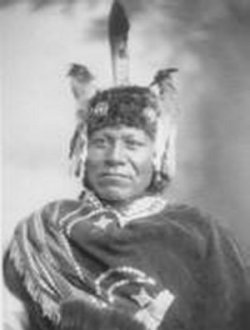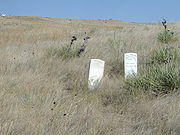
Mitch Bouyer
Encyclopedia

American Civil War
The American Civil War was a civil war fought in the United States of America. In response to the election of Abraham Lincoln as President of the United States, 11 southern slave states declared their secession from the United States and formed the Confederate States of America ; the other 25...
. General John Gibbon
John Gibbon
John Gibbon was a career United States Army officer who fought in the American Civil War and the Indian Wars.-Early life:...
called him "next to Jim Bridger
Jim Bridger
James Felix "Jim" Bridger was among the foremost mountain men, trappers, scouts and guides who explored and trapped the Western United States during the decades of 1820-1850, as well as mediating between native tribes and encroaching whites...
, the best guide in the country". He was killed at the Battle of the Little Bighorn
Battle of the Little Bighorn
The Battle of the Little Bighorn, also known as Custer's Last Stand and, by the Indians involved, as the Battle of the Greasy Grass, was an armed engagement between combined forces of Lakota, Northern Cheyenne and Arapaho people against the 7th Cavalry Regiment of the United States Army...
.
Family background
He was born Michel Bouyer in 1837. His father, Jean-Baptiste Bouyer, was a French Canadian who was employed by the American Fur CompanyAmerican Fur Company
The American Fur Company was founded by John Jacob Astor in 1808. The company grew to monopolize the fur trade in the United States by 1830, and became one of the largest businesses in the country. The company was one the first great trusts in American business...
, trading with Sioux in the Wyoming area. Mitch's mother was a Santee Sioux
Sioux
The Sioux are Native American and First Nations people in North America. The term can refer to any ethnic group within the Great Sioux Nation or any of the nation's many language dialects...
. His father was killed by Indians while trapping, about 1863. Mitch's Indian name was Kar-pash. He had three full sisters: Marie, Anne, and Thérèse, who seem to have been triplets
Multiple birth
A multiple birth occurs when more than one fetus is carried to term in a single pregnancy. Different names for multiple births are used, depending on the number of offspring. Common multiples are two and three, known as twins and triplets...
born in 1840. He also had at least two half-brothers: John Bouyer (c. 1845-1871), who was hanged at Fort Laramie for killing an Army scout in the first legal execution in Wyoming Territory
Wyoming Territory
The Territory of Wyoming was an organized incorporated territory of the United States that existed from July 25, 1868, until July 10, 1890, when it was admitted to the Union as the State of Wyoming. Cheyenne was the territorial capital...
, and Antoine Bouyer (born 1852?), whom Walter Mason Camp
Walter Mason Camp
Walter Mason Camp was a respected editor, author, railroad expert and historical researcher.He was born in Camptown, Pennsylvania, and was educated at the Pennsylvania State College. From 1897 until his death, he was the editor of The Railway and Engineering Review a railroad construction and...
interviewed in 1912. John, in an interview just before he was hanged, stated that there had been other siblings who had already died.
Mitch was an interpreter at Fort Phil Kearny
Fort Phil Kearny
Fort Phil Kearny was an outpost of the United States Army that existed in the late 1860s in present-day northeastern Wyoming along the Bozeman Trail. Construction began Friday July 13, 1866 by Companies A, C, E and H of the 2nd Battalion, 18th Infantry, under the direction of the regimental...
in 1868. In the fall of 1869, he married a young Crow
Crow
Crows form the genus Corvus in the family Corvidae. Ranging in size from the relatively small pigeon-size jackdaws to the Common Raven of the Holarctic region and Thick-billed Raven of the highlands of Ethiopia, the 40 or so members of this genus occur on all temperate continents and several...
woman named Magpie Outside (or Magpie Out-of-Doors), who became known as Mary. Their first child, also named Mary, was born in 1870. Sometime later they also had a son, apparently named Tom, but eventually called James LeForge (see below).
Army scout and death at the Little Big Horn
Bouyer became a guide for the 2nd U.S. Cavalry, working with the Northern Pacific Railroad's survey team. From 1872 on he was employed by the Crow Agency and the US Army.In 1876 Lt. Col. George Armstrong Custer
George Armstrong Custer
George Armstrong Custer was a United States Army officer and cavalry commander in the American Civil War and the Indian Wars. Raised in Michigan and Ohio, Custer was admitted to West Point in 1858, where he graduated last in his class...
requested that Bouyer be transferred to the 7th U.S. Cavalry as an interpreter for the Crow
Crow
Crows form the genus Corvus in the family Corvidae. Ranging in size from the relatively small pigeon-size jackdaws to the Common Raven of the Holarctic region and Thick-billed Raven of the highlands of Ethiopia, the 40 or so members of this genus occur on all temperate continents and several...
scouts when Gen. Alfred Terry
Alfred Terry
Alfred Howe Terry was a Union general in the American Civil War and the military commander of the Dakota Territory from 1866 to 1869 and again from 1872 to 1886.-Early life and career:...
ordered the 7th south from the Montana Column to search for hostile Indians. Custer's regular scouts were Ree (Arikara
Arikara
Arikara are a group of Native Americans in North Dakota...
). However, for this mission, Terry had assigned six of Lt. James Bradley
James Bradley
James Bradley FRS was an English astronomer and served as Astronomer Royal from 1742, succeeding Edmund Halley. He is best known for two fundamental discoveries in astronomy, the aberration of light , and the nutation of the Earth's axis...
's Crow scouts to the 7th (including Curley
Curley
Ashishishe , known as Curly , was a Crow scout in the United States Army during the Sioux Wars, best known for having been one of the few survivors on the United States side at the Battle of Little Bighorn. He did not fight in the battle, but watched from a distance, and was the first to report the...
). Bouyer had the additional bonus of knowing the country well.
At the Crow's Nest, Bouyer was one of the scouts who warned Custer about the size of the Indian village, which Custer claimed he couldn't make out. Bouyer told him, "General, I have been with these Indians for 30 years, and this is the largest village I have ever known of." After failing to convince Custer, it is reported Bouyer gave away his possessions, convinced he would die in the coming battle. There was a report that Sitting Bull
Sitting Bull
Sitting Bull Sitting Bull Sitting Bull (Lakota: Tȟatȟáŋka Íyotake (in Standard Lakota Orthography), also nicknamed Slon-he or "Slow"; (c. 1831 – December 15, 1890) was a Hunkpapa Lakota Sioux holy man who led his people as a tribal chief during years of resistance to United States government policies...
had offered a bounty
Bounty (reward)
A bounty is a payment or reward often offered by a group as an incentive for the accomplishment of a task by someone usually not associated with the group. Bounties are most commonly issued for the capture or retrieval of a person or object. They are typically in the form of money...
of 100 ponies for Bouyer's head.
When Custer's command was divided into 3 battalion
Battalion
A battalion is a military unit of around 300–1,200 soldiers usually consisting of between two and seven companies and typically commanded by either a Lieutenant Colonel or a Colonel...
s, about noon, Bouyer was assigned to accompany Custer, whose battalion would be almost completely wiped out. There were only about a dozen survivors of Custer's battalion, all of whom had left it before the battle began. Soldiers in Reno's
Marcus Reno
Marcus Albert Reno was a career military officer in the American Civil War and in the Black Hills War against the Lakota and Northern Cheyenne...
fight claimed to have seen Custer on the bluffs watching the retreat, but this was later shown probably to have been Bouyer and Curley, who had ridden ahead of the main force. Bouyer stayed with Custer and was killed in the Battle of the Little Big Horn.

Human skull
The human skull is a bony structure, skeleton, that is in the human head and which supports the structures of the face and forms a cavity for the brain.In humans, the adult skull is normally made up of 22 bones...
was found that was identified as Bouyer's by comparison of the facial bones with the only photograph known of him. The skull was found to the west of the monument on Custer Hill, at what is called the 'South Skirmish Line'.
Bouyer seems to have been a flamboyant
Flaming
Flaming, also known as bashing, is hostile and insulting interaction between Internet users. Flaming usually occurs in the social context of an Internet forum, Internet Relay Chat , Usenet, by e-mail, game servers such as Xbox Live or Playstation Network, and on video-sharing websites...
character. In the photograph, he is wearing a fur hat with 2 woodpecker
Woodpecker
Woodpeckers are near passerine birds of the order Piciformes. They are one subfamily in the family Picidae, which also includes the piculets and wrynecks. They are found worldwide and include about 180 species....
s one on either side, and he was wearing a piebald
Piebald
A piebald or pied animal is one that has a spotting pattern of large unpigmented, usually white, areas of hair, feathers, or scales and normally pigmented patches, generally black. The colour of the animal's skin underneath its coat is also pigmented under the dark patches and unpigmented under...
calf's vest the day of the fatal battle.
After Bouyer's death, his widow Mary was taken in by his close friend, Thomas Leforge
Thomas Leforge
Thomas H. Leforge was the author of Memoirs of a White Crow Indian, his highly detailed account of living among the Crow Indian nation during the mid-to-late 19th century, first published in March 1928 by The Century Company at the hand of one Thomas Marquis, and republished by the University of...
. When his own wife died, Leforge married Mary and adopted her children. This is probably when Mitch's son was renamed, as Leforge had a son of his own named Tom. Mary died in 1916.
Accusation of duplicity
In 1985, more than a century after the Bouyer's death, Henry Weibert and his son Don published a book called Sixty-Six Years in Custer's Shadow, in which they analyzed the battle in light of their intimate knowledge of the terrain. Amongst their theories was the idea that the Seventh Cavalry had been led by Bouyer into a trap. Though other writers had speculated the Seventh might have been entrapped, this was the only book to point a finger at Bouyer. Historians ridiculed the idea, saying that it was contrary to everything known about Bouyer's character. Furthermore, it would have been a personal betrayal of his family and friends of many years' standing among the Crow.In a later book, written after his father died, Don Weibert, though repeating many of the earlier conclusions about how the battle was fought, dropped the claim that Bouyer had betrayed Custer.

